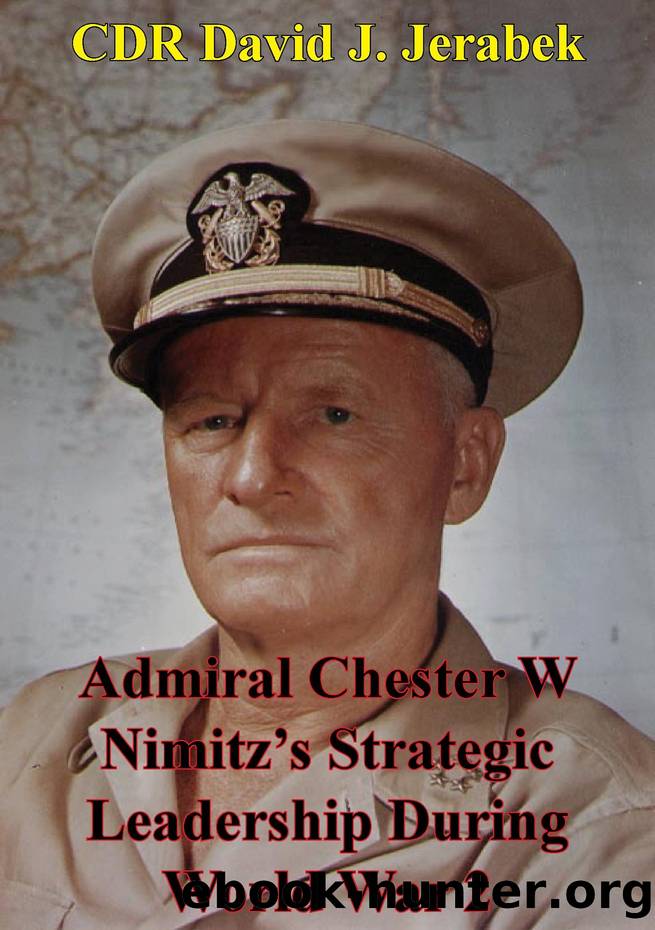Admiral Chester W Nimitz's Strategic Leadership During World War 2 by CDR David J. Jerabek

Author:CDR David J. Jerabek
Language: eng
Format: epub
Publisher: Pickle Partners Publishing
Published: 2014-07-31T00:00:00+00:00
TECHNICAL COMPETENCIES
I consider the technical competencies to be more applicable to todayâs national strategic-level leaders than to a WW II warfighting CINC. I will therefore give little emphasis to them, with the exception of the leaderâs ability to perform in a joint and combined environment.
At the outbreak of World War II, Admiral Nimitz, then the Chief of Naval Personnel, had his only opportunity to operate in the national political arena. In that capacity he was very effective âon the hillâ obtaining congressional approval of the measures he needed to man a wartime Navy.{64} As a theater CINC â during wartime, Admiral Nimitz did not have the opportunity, nor was it his place, to become involved in national level political issues. He was though, very effective at utilizing Admiral King, and if necessary Secretary Knox, to bring strategic or programmatic issues to the appropriate light, that required approval outside his chain of command. Nimitz also used Admiral Kingâs relationship and access to General Marshall when he encountered inter-service difficulties within the âdual-commandedâ Pacific theater.{65}
As previously mentioned, Nimitz was extremely demanding of his commanders and kept only the best to be on his âfirst team.â{66} And Nimitz demanded jointness from his commanders. Prior to the Tarawa campaign, Nimitz called together his senior commanders â Navy, Army, and Marine â and communicated the importance of jointness for the operation; âIf I hear one case of a naval officer not giving required help to the Army ashore, I will immediately relieve him.â{67} No questions were asked.
As the war progressed, and his theater got more âjointâ, Nimitz made two major changes to accommodate. In the summer of 1943, Nimitz needed an improvement to his current supply system which couldnât contend with the growing complexity and expanse of the Pacific theater.{68} Nimitz saw the advantages of the Army system of supply, with its, as Hoyt puts it, âconstant infusion of supply, and a planning and delivery network as complex as the fighting system itselfâ{69} â and adopted it. In September 1943, he set up a true joint theater headquarters at Pearl Harbor that initially had four directorates; Plans (J-1), Intelligence (J-2), Operations (J-3), and Logistics (J-4).{70}
With the Pacific being secondary to Europe as a theater of war, there was little, or no, occasion to operate combined. But when the opportunity presented itself Nimitz was eager, as well as effective. During planning for the Guadalcanal campaign, Admiral Nimitz saw an opportunity to utilize New Zealand troops. When he questioned Admiral Ghormley (3rd Fleet Commander at that time and in charge of the operation) about the possibility, Ghormley could only provide negatives. Nimitz responded, âIf we canât find a formula for using them, it is Japanâs gain. We should use all resources that are available to us.â{71} Throughout the brief Ghormleyâs pessimism persisted, causing Nimitz to close the meeting by emphasizing, âI repeat again â if we canât use our allies, we are damned fools.â{72} As Iâve already mentioned, Admiral Ghormley wasnât around for the end of the Guadalcanal campaign.
Download
This site does not store any files on its server. We only index and link to content provided by other sites. Please contact the content providers to delete copyright contents if any and email us, we'll remove relevant links or contents immediately.
| Central Asia | Southeast Asia |
| China | Hong Kong |
| India | Japan |
| Korea | Pakistan |
| Philippines | Russia |
The Sympathizer by Viet Thanh Nguyen(4344)
The Rape of Nanking by Iris Chang(4170)
World without end by Ken Follett(3446)
Ants Among Elephants by Sujatha Gidla(3442)
Blood and Sand by Alex Von Tunzelmann(3168)
Japanese Design by Patricia J. Graham(3139)
The Queen of Nothing by Holly Black(2546)
City of Djinns: a year in Delhi by William Dalrymple(2533)
Foreign Devils on the Silk Road: The Search for the Lost Treasures of Central Asia by Peter Hopkirk(2445)
India's Ancient Past by R.S. Sharma(2433)
Inglorious Empire by Shashi Tharoor(2414)
Tokyo by Rob Goss(2408)
In Order to Live: A North Korean Girl's Journey to Freedom by Yeonmi Park(2362)
Tokyo Geek's Guide: Manga, Anime, Gaming, Cosplay, Toys, Idols & More - The Ultimate Guide to Japan's Otaku Culture by Simone Gianni(2346)
India's biggest cover-up by Dhar Anuj(2337)
The Great Game: On Secret Service in High Asia by Peter Hopkirk(2318)
Goodbye Madame Butterfly(2231)
Batik by Rudolf Smend(2155)
Living Silence in Burma by Christina Fink(2049)
